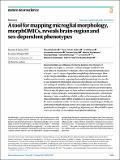| dc.contributor.author | Colombo, Gloria | |
| dc.contributor.author | Cubero, Ryan John A | |
| dc.contributor.author | Kanari, Lida | |
| dc.contributor.author | Venturino, Alessandro | |
| dc.contributor.author | Schulz, Rouven | |
| dc.contributor.author | Scolamiero, Martina | |
| dc.contributor.author | Agerberg, Jens | |
| dc.contributor.author | Mathys, Hansruedi | |
| dc.contributor.author | Tsai, Li-Huei | |
| dc.contributor.author | Chachólski, Wojciech | |
| dc.contributor.author | Hess, Kathryn | |
| dc.contributor.author | Siegert, Sandra | |
| dc.date.accessioned | 2023-04-04T17:56:05Z | |
| dc.date.available | 2023-04-04T17:56:05Z | |
| dc.date.issued | 2022 | |
| dc.identifier.uri | https://hdl.handle.net/1721.1/150410 | |
| dc.description.abstract | <jats:title>Abstract</jats:title><jats:p>Environmental cues influence the highly dynamic morphology of microglia. Strategies to characterize these changes usually involve user-selected morphometric features, which preclude the identification of a spectrum of context-dependent morphological phenotypes. Here we develop MorphOMICs, a topological data analysis approach, which enables semiautomatic mapping of microglial morphology into an atlas of cue-dependent phenotypes and overcomes feature-selection biases and biological variability. We extract spatially heterogeneous and sexually dimorphic morphological phenotypes for seven adult mouse brain regions. This sex-specific phenotype declines with maturation but increases over the disease trajectories in two neurodegeneration mouse models, with females showing a faster morphological shift in affected brain regions. Remarkably, microglia morphologies reflect an adaptation upon repeated exposure to ketamine anesthesia and do not recover to control morphologies. Finally, we demonstrate that both long primary processes and short terminal processes provide distinct insights to morphological phenotypes. MorphOMICs opens a new perspective to characterize microglial morphology.</jats:p> | en_US |
| dc.language.iso | en | |
| dc.publisher | Springer Science and Business Media LLC | en_US |
| dc.relation.isversionof | 10.1038/S41593-022-01167-6 | en_US |
| dc.rights | Creative Commons Attribution 4.0 International license | en_US |
| dc.rights.uri | https://creativecommons.org/licenses/by/4.0/ | en_US |
| dc.source | Nature | en_US |
| dc.title | A tool for mapping microglial morphology, morphOMICs, reveals brain-region and sex-dependent phenotypes | en_US |
| dc.type | Article | en_US |
| dc.identifier.citation | Colombo, Gloria, Cubero, Ryan John A, Kanari, Lida, Venturino, Alessandro, Schulz, Rouven et al. 2022. "A tool for mapping microglial morphology, morphOMICs, reveals brain-region and sex-dependent phenotypes." Nature Neuroscience, 25 (10). | |
| dc.contributor.department | Massachusetts Institute of Technology. Department of Brain and Cognitive Sciences | en_US |
| dc.relation.journal | Nature Neuroscience | en_US |
| dc.eprint.version | Final published version | en_US |
| dc.type.uri | http://purl.org/eprint/type/JournalArticle | en_US |
| eprint.status | http://purl.org/eprint/status/PeerReviewed | en_US |
| dc.date.updated | 2023-04-04T17:48:07Z | |
| dspace.orderedauthors | Colombo, G; Cubero, RJA; Kanari, L; Venturino, A; Schulz, R; Scolamiero, M; Agerberg, J; Mathys, H; Tsai, L-H; Chachólski, W; Hess, K; Siegert, S | en_US |
| dspace.date.submission | 2023-04-04T17:48:26Z | |
| mit.journal.volume | 25 | en_US |
| mit.journal.issue | 10 | en_US |
| mit.license | PUBLISHER_CC | |
| mit.metadata.status | Authority Work and Publication Information Needed | en_US |
